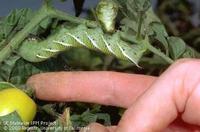Pests
Here's a collection of our monthly tips about managing various pests, weeds, diseases, or other conditions.
Pest Tips
Ailing Ornamental TreesIf you have an ailing tree, here are some questions you can ask yourself to begin diagnosing the problem: is the entire canopy of the tree affected? If the answer is yes, you can reasonably guess that something is wrong below the soil. A lack of nutrients (refer to the UC Pest Note on Mineral Deficiencies) will likely cause the leaves to either die (necrosis) or lose color (chlorosis). Too much or too little water will also cause foliage problems (See UC Pest Note on Poor Water Management, Poor Drainage). If only parts of the tree are affected, it is likely your problem is above ground. Is there a pattern to the distress? You can rule out or suspect sunscald by determining which side of the tree faces the harshest sun (UC Pest Note on Sunburn). What kind of tree is it? Is there new growth? If there is, that’s a great sign that a single event rather than an ongoing problem distressed your tree. The UC IPM website will direct you to species-specific pests and disorders to begin diagnosing your tree's ailments. |
Almond and Walnut HarvestAlmonds are harvested when the shell is cracked and brown. Freeze nuts for 1-2 weeks to kill resident worms, store nuts in plastic bags to prevent re-infestation, and spray the tree with fixed copper during or after leaf fall but before rains start to reduce damage from shot hole fungus. Walnuts are fully mature when the green hull begins to break away from the shell. Harvest by polling or shaking the tree. Remove the green hulls, then freeze nuts in the shell to kill any resident worms. Store in plastic. |
Ant ControlOn outdoor and sometimes indoor plants, ants protect and care for honeydew-producing insects such as aphids, soft scales, whiteflies, and mealybugs, increasing damage from these pests. Ants are among the most prevalent pests in households. UC IPM offers steps to follow in an Ant Emergency. Ant management requires diligent efforts and the combined use of mechanical, cultural, sanitation, and often chemical control methods. It is unrealistic and impractical to attempt to totally eliminate ants from an outdoor area. Focus your management efforts on excluding ants from buildings or valuable plants and eliminating their food and water sources. Reducing outdoor sources of ants near buildings will reduce the likelihood of ants coming indoors. Ants on Trees and Shrubs For more information about what ant baits and insecticides to use, please consult the UC Pest Note on Ants. |
AphidsHave you noticed that different plants attract aphids of different colors and shapes? Once you’re done admiring nature, you may want to take action to protect your plants. Aphids are classified as sucking insects, which means that they suck the juices right out of plants. They take the nutrients needed for plant growth, and the plant will start to get weak and possibly die. If you monitor your garden regularly and find aphids when their population is still small, you may be able to simply knock or hose them off the plant or prune out the infected part of the plant. When aphid populations are large, nature can help you control them — beneficial insects will be attracted to eat the aphids.
You can encourage beneficial insects in your garden by including a variety of plants that flower at different times throughout the season. Avoid chemicals that kill good and bad indiscriminately. If ants are protecting the aphids in a plant, control the ants. Decide what population you will tolerate in your garden, and have patience because it can take time to establish a healthy ecosystem. More information: Aphid management guidelines in English| Spanish |
Armillaria Root RotMushrooms at the base of a tree could signal a problem with the tree. Armillaria is a fungus that can live in the soil for many years. It can rot the roots and cause leaves and branches to die and can eventually kill a plant. Another common term is Oak Root Fungus, although it affects many different species of trees and even some herbaceous plants. Often by the time the fruiting bodies (mushrooms) are visible, much damage has already been done. It feeds on both live and decaying wood. Cutting back a small section of bark can reveal white fan-shaped or black stringy fungus which aids in diagnosis. Keeping the plant healthy provides some defense. Fungi thrive in moist conditions, so do not overwater the area. Also, keep mulch and other plants away from the trunks of trees so as not to hold moisture against the crown (base). The best defense against this disease is to plant resistant varieties.
For information: Armillaria Root Rot |
Armored Scale ControlThese parasites suck the living sap from shrubs and trees. Armored scale insects are in the crawler stage in early summer (June). Armored scale has a hard stage that is very resistant to sprays. Control them during the crawler stage when they are soft and vulnerable. Spray with a horticultural (not dormant) oil, once a month for three months. See the UC Pest Note on Scales for important information about spraying. |
Avocados, Brown SpotThe brown patch that looks like a turtle's back is called Carapace Spot. It is corky and usually cracked into angular divisions. It is caused by rubbing or brushing of tender young fruit on leaves or stems in the wind, but the fruit is usually undamaged under the spot. Just cut out the spot. More pictures of avocado problems can be found on UC Pest Note On Causes of Avocado Fruit Damage. |
Bagrada Bug
|
BirdsBirds can cause extensive damage to tree fruit crops. Unlike squirrels, birds are more likely to peck at one piece of fruit until it’s gone. If they are doing too much damage, netting over a tree can keep them away from the fruit. If you use visual repellents (such as Mylar streamers or noisemakers) to frighten them, be sure to vary the method so that the birds don’t become immune to the effects. Read the UC Pest Note on Birds on Tree Fruits and Vines for more information. |
Bitter Pit (Brown Spots) on Apples
For even more information, the UC Postharvest Technology Center website has grower information, including using calcium sprays starting in June. |
Boxwood BlightBoxwood is an evergreen shrub typically grown as a short border hedge. It is often pruned in a straight, formal style. It has been falling out of favor as native, drought-resistant plantings are increasing in popularity. Another reason for reconsidering its use is the fairly recent arrival of a fungal disease called Boxwood Blight. It was first detected in the U.S. in Connecticut in 2011 and reported in Santa Clara County in 2017. It is spread by contact through pruning tools, gardeners’ clothing, and irrigation. This blight can show symptoms in as little as a week. Look for brown leaf spots with dark edges, white spores on the undersides of leaves, black lesions on stems, and severe dieback. Humidity and overhead watering contribute to the disease being able to take hold. Pruning infected branches, with sterilization of tools between each cut, may help. Fungicides cannot control the disease once it starts. More likely the plant will have to be removed, bagged, and thrown in the garbage.
Boxwood Blight, Purdue Botany and Plant Pathology
|
Brown Marmorated Stink BugNative to Eastern Asia, this pest was introduced to the United States in the 1990s and has been established in Santa Clara County. Some features to distinguish these bugs from other stink bugs are white stripes on the antennae, a blunt head shape, and smooth shoulder margins.
They feed and reproduce on a variety of plants and are particularly damaging to fruit. You can cut cosmetic damage off fruit and still eat the rest of the fruit. To keep out stink bugs, cover vegetable plants with row covers. You can pick the bugs off plants and squish them or knock them off into soapy water. They are attracted to light and can get into homes where if vacuumed up, they can stink up your vacuum bag. More Information: Brown Marmorated Stick Bug Pest Note
|
Brown Rot on Apricot and Peaches
|
Bug PatrolIt’s never helpful to have critters competing with you for your food. Damage can be done by squirrels, raccoons, rats, birds, and caterpillars, yet it is the tiniest creatures that can be the hardest to detect. That’s why it’s helpful to do a regular inspection, as often as once or twice a day if possible. Knowing what it is will help you figure out what to do to maximize the productivity of your garden. Some pests are out during the day and others do their damage at night, so you may want to take a flashlight out at non-peak gardening hours. Holding a piece of white paper under a plant and shaking the plant can make insects fall off for identification. The most common place to find pests is on the undersides of leaves so make sure to closely inspect those parts. A magnifying glass of some sort is a useful tool. You can also take a picture with your cell phone and then zoom in for a closer view. It’s important to be able to recognize the eggs, the larval and nymph stages, and the adult form, and to be able to differentiate between beneficial insects and harmful pests. Don’t indiscriminately squish everything that moves! Once you have done your detective work, you can go to the University of California IPM website for identification and management tips, or contact the Master Gardener Help Desk for guidance.
More Information: Beneficial Predators – These are the ones you want!
|
Cabbage AphidsThe grey-green cabbage aphid is often found on cool season vegetables. They prefer to feed on the youngest leaves and flowering parts and are often seen on cabbages, broccoli, and Brussels sprouts. Hose them off plants or prune out infestations. Grow flowers in your vegetable garden to attract beneficial insects, which are their natural enemies. See UC Pest Note on Cabbage Aphid to identify and manage this insect. |
Camellia Petal Blight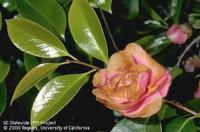
More information: Camellias Petal Blight |
Citrus Bud Mite - Leave It Alone
It attacks newly forming flowers and fruits. The mite is only visible with a magnifying glass and has a elongated yellow body with four legs that appear to come out of its head. The mites feed inside the buds, killing them or causing a rosette-like growth of the subsequent foliage and distortion of flowers and fruit. The problem is usually limited to just a few fruit on the tree. Previously recommended oil sprays have not been proved effective. This is one of those pests that is best left alone. The oddly-shaped fruit is edible. For more information see UC Pest Note on Citrus Bud Mite. |
Citrus Leaf DropLeaf drop from citrus trees is normal. Washington Navel oranges may lose over 3,000 leaves a day during peak leaf drop in the spring. Valencia oranges may lose about 1500 a day. Problems that can cause excessive leaf drop beyond these numbers are lack of water and a heavy infestation of spider mites. The tree's leaves will have brown spots if affected by the mites. You can wash them off with a strong water spray. Bud and small fruit drop is also normal. For further information see UC Pest Note on Diseases and Disorders of Citrus Leaves and Twigs. |
Citrus Sooty LeavesSooty mold on citrus may be a byproduct of sucking insects such as aphid, mealy bug, soft scale or whitefly. Ants will protect these pests against predators in exchange for the honeydew that the pests produce. The sooty mold grows on the honeydew. Try washing off the sucking insects with a strong water stream. The next step is control of the ants. Ants may be managed by applying a sticky compound around the trunk and trimming limbs touching buildings or other access points. Baits at the base of the tree also help. For more information about specific controls, see the UC Pest Note on Sooty Mold. |
Clean Up Fallen FruitPick up fallen fruit daily to prevent attracting critters or diseases. If your fruit is being eaten at night then rats are the likely culprit, if it's during the day it may be squirrels. Holes, rather than bites, are made by birds. In addition to harvesting regularly, ripening fruit can be protected with a netting fine enough to exclude birds and small animals |
Codling Moth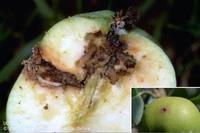
Codling moth larvae bore into the center of fruit to feed. Note the excrement, including the frass pushed out of the entry hole, Jack Kelly Clark, UC.
Trees should be monitored every week for signs of infestation. Infested fruit should be removed and discarded to break the codling moth life cycle. Sanitation is an important non-chemical step in controlling this pest. Make sure to pick up fallen fruit promptly, and pick apples with holes that are still on the tree. This will keep future populations down. Pheromone traps can be hung in isolated trees. But if you have just one apple tree don't bother. You will just attract codling moths to your tree. Fruit can be bagged for protection, but this method is very labor-intensive. Heavy infestations may require the use of pesticides, but proper timing of sprays is critical. Read the UC Codling Moth Pest Note for more information. |
Control Insect Pests with Horticultural OilSpray apple, pear, peach and nectarine, apricot trees with horticultural oil during the dormant period to control scale, and aphid and mite eggs. For more information on using horticultural oil to control pests consult: |
Controlling Bermudagrass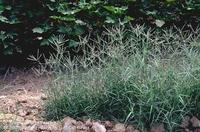
|
Cottony Cushion ScaleScale insects populate the stems or branches of plants and suck out the nutrients. Some are soft and some are armored during part of the life cycle. Cottony cushion scale is a soft variety that is often seen on apple trees. The crawlers are reddish and the females develop elongated white egg sacs on their backs, but it is most likely the molting skins that look like cotton that will alert you to their presence. Small infestations can sometimes be wiped off with gloved fingers. Natural predators may also move in to take care of the problem. There are beetles and parasitic flies that can provide good control. Keeping ants out of the tree will also help because ants will protect the pests in order to be able to eat their sugary exudate.
More information: Cottony Cushion Scale Pest Note |
DeerAlthough there's no such thing as a deer-proof plant, some can be called deer-resistant. Plants with strong smells, woolly or hairy leaves, or prickly or thorny parts are less appetizing to deer. Other strategies include deer repellents, enclosing plants in wire cages, netting, or tall fences. Read more in the UC Pest Note on Deer and use our search for Deer Resistant Plants. |
Don't Move Firewood
More Information: Don’t Move Firewood campaign
|
Dormant Oil SprayingDeciduous fruit trees lose their leaves seasonally, usually in the autumn. They enter a period of dormancy when they are not actively growing and there is little activity within the plant. This is the time to apply dormant oil sprays to smother soft-bodied insects such as scale, aphids, and mites. First, do any needed pruning so that you will not be spraying branches that will soon be removed. Then inspect for pests that are overwintering on the trees, or remember pest and disease problems you noticed during the growing season. Although dormant oils may count as organic, it is still best to use them only if pest problems have been observed.
Mix the horticultural oil in a sprayer and apply it according to directions on the packaging. Never use more than what is prescribed. Make sure to complete the spraying before the trees start to bud and blossom so as not to damage developing flowers and fruit.
More Information: Calendar of Backyard Gardening Operations for Selected Fruit and Nut Trees and Dormant Spraying of Fruit Trees
|
EarwigsEarwigs are third only to snails and slugs in causing plant damage. While they are beneficial because they eat insects such as aphids, they also feed on soft plants. Earwigs can do quite a lot of damage if there is a high population. They feed at night and hide in moist, tight-fitting places during the day. Trap them by putting out moistened, tightly rolled newspaper or corrugated cardboard in the evening. In the morning dispose of the paper and the trapped insects. Other control methods are described in the UC Pest Note on Earwigs. |
Eugenia PsyllidThis psyllid has been a real problem in California. New leaves on the infected Eugenia look very much like peach leaf curl. The leaves also may become discolored. Thanks to the diligent work of the entomology researchers in biological insect control at UC Berkeley, a parasitic wasp called Tamarixia was released in Santa Clara County in 1993. The wasp is known to go as far as 45 miles and is found throughout the county. It is essential that no insecticide be used on Eugenia species. The Tamarixia wasp cannot do its job if it's poisoned. For more information see the UC Pest Note on Psyllids. |
Fire Blight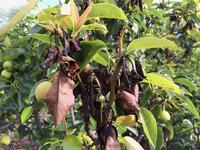
It is spread by insects, rain, or pruning. The bacteria enter through the blossoms and travel down the tree. If left unchecked, fire blight can enter the trunk and kill the entire tree. Prune infected branches back to healthy wood, at least eight inches below visible damage. If the inside of the branch is discolored, you need to cut back still further. Clean pruning tools between cuts so as not to spread the infection. A less effective way to control fire blight is to spray the open blossoms with a copper spray. Planting varieties that are less prone to fire blight is helpful. Always promptly clean up fallen fruit and leaves. For more information, see the UC Pest Note on Fire Blight. |
Fruit DamageIf your fruits are ready to pick and you don't get to them first, there are critters that will let you know when they are ripe. For example, for citrus, snails leave little holes in the outside peel, rats hollow out the fruit and squirrels carry them off, often leaving partly eaten fruit on a nearby fence. To determine what’s eating your fruit - start by narrowing down the list of possible pests in your area. Check the damage to determine whether it is likely caused by insects, birds, or rodents. Determine what time of day the damage happens. Squirrels are active during the daytime, and rats are mainly active at night. Look for other signs, such as placement of the damaged fruits, tracks, and possibly droppings, and compare that to the habits of the pest you suspect. When you are sure what the pest is, you can take appropriate action to protect your fruits. Resources: |
Fusarium WiltThis is the most prevalent and damaging tomato disease. It also starts with the yellowing of lower leaves, but the yellowing may be only on one side (stopping at midrib) of the leaf or just one branch or one side of the plant. The older leaves will droop and curve downward. The yellow leaves wilt and die, gradually killing the whole plant. Sometimes a single shoot is killed before the rest of the plant shows any damage. More information at UC Pest Note on Fusarium Wilt. |
Garden SanitationKeeping the garden clean can help keep it healthy. Remove spent blossoms, fruit, and other plant parts as your plants finish producing. Dead and decaying plant parts can attract pests and give them safe places to breed. Insect pests damage plants directly by eating material or sucking out juices and nutrients, and they also spread diseases between plants as they move around. Weeds compete with desirable plants for water and nutrients and even sunlight, so remove them promptly. Older leaves of some plants, like squash vines, may naturally turn yellow and die. Removing them early allows the plants’ energy to go into the actively growing parts. Pick up fallen fruit that can attract rodents and can also return disease pathogens to the soil and plant. It’s particularly important to remove dried-up fruit “mummies” so that the fungal spores don’t spread. Prune dying tree branches before they can fall and do damage. Some flowering plants will produce more flowers if you remove spent blooms, a process called deadheading. You can leave healthy fallen leaves in place to form a mulch and decompose naturally, or you can rake them up and add them to the compost pile with other disease-free plant material. Do not compost diseased material.
More information: What Does Plant Disease Sanitation Really Mean?
|
Giant Whiteflies
|
GophersHave you ever watched a plant wiggle and then disappear underground right before your very eyes? That’s the work of a gopher. You don’t often see them because they spend most of their time in underground tunnels, but you see the damage they do by chewing on plant roots or irrigation lines. One way to distinguish them from other soil-dwelling vertebrate pests is by the crescent-shaped mounds of dirt they make when they dive back down. Fresh mounds of moist soil are an indication of recent activity. They do not hibernate, so they are busy year-round. They can be eliminated through trapping and dispatching. Gophinator, Macabee, and Cinch traps specifically designed for gophers are the most commonly used. You can plant trees and shrubs in gopher baskets in the ground to protect their roots. You can also line the bottom of raised beds with hardware cloth to keep the gophers from burrowing up into the beds.
More information: Gopher Pest Note |
Gray Mold (Botrytis)Botrytis is gray or brownish fuzzy mold that can attack a wide variety of plants. It likes flower petals, ripening fruits and vegetables, as well as leaves and stems. The spores are spread through the air. It is most severe when there's high humidity and may start forming on decaying matter. According to the UC Pest Note on Botrytis Blight, it is important to remove debris and prunings from the ground. You may even have to pick up flowers daily. Avoid overhead watering. UC also has information about Gray Mold on Strawberries. |
Gummosis in Stone FruitGummosis is a general term that refers to the oozing of sap. The most common cause in stone fruit is a fungal disease called Cytospora canker. The fungus infects the tree through wounds and the sap is usually amber-colored and free of sawdust. Tree borers can also cause gummosis. In this case, the sap may contain sawdust or other debris. Mechanical injuries and sun scald can also cause sap to leak and open the tree to infection. Advice to prevent and deal with it includes following good pruning practices, protecting tree trunks and limbs from sun scald, and pruning out diseased wood past the point of infection. More information from Utah State University in their summary of cytospora canker.
|
Healthy TomatoesTomatoes are one of the most popular vegetables in home gardens, largely because of the taste difference between a homegrown tomato and a store-bought tomato. Here are a few things to watch out for to keep the plants healthy. Regular watering helps nutrients flow throughout the plant and can prevent blossom end rot. Clean soil and sanitation reduce the common Verticillium wilt in which lower and older leaves turn yellow and brown. And russet mite, where lower leaves and stems appear a greasy bronze, can be controlled with sulfur dust.
|
LeafminersWatch for damage from leafminers on many types of plants, including leaves of vegetables and commonly on citrus. Eggs can either be inserted into leaves or laid on the surface of leaves. In either case, the larvae feed between leaf surfaces, creating a "mine". If eggs are on the surface of the leaf, they can be rubbed off before hatching. Plant resistant species or varieties. Small seedlings can be protected by protective cloth. On plants such as cole crops, lettuce, and spinach, clip off and remove older infested leaves. Place leaves in plastic bag, and put bag in trash. Leafminers are often kept under good control by natural parasites. Insecticides are not very effective for leafminer control. See UC Pest Note on Leafminers for additional information. |
Manage Pests with "Integrated Pest Management"You see insects in your garden and your first reaction may be to reach for neem oil or other insecticides to kill off the little invaders. But wait! Chemical intervention may not work, might not be necessary, and may even kill off beneficial creatures that your garden needs. Instead, determine first whether the pest really is a pest. This UC plant diagnostic tool can help figure that out and provide mitigation options. Identification is a key element of Integrated Pest Management (or IPM), a process Master Gardeners suggest you use to solve pest problems while minimizing risk to people and the environment.
More information: What is IPM?
|
Mistletoe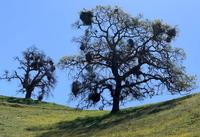
More information: Mistletoe Quick Tips
|
MolesYou and the moles will probably never see each other: they won’t see you due to very poor vision and you won’t see them because they live underground. But you will see the damage they do. Unlike gophers which eat plant roots, moles eat insects and worms. Yet they can do collateral damage to plant roots as they tunnel through in search of their preferred food. Plants can also suffer if the tunnels redirect water away from the roots when you try to irrigate. Moles create what look like mountain ridges as they tunnel through near the surface, and they leave behind round mounds of soil when they dive deep. The most effective way to manage them is to use traps specifically designed for moles.
|
Mosaic VirusMosaic virus on squash and cucumber plants is a disease spread by aphids and cucumber beetles. The leaves become rough and mottled, the plant becomes stunted and the fruit can be whitish. Pull the plant and put it in the trash. Do not compost. For more information see UC Pest Note on Squash Mosaic Virus. |
Neem Oil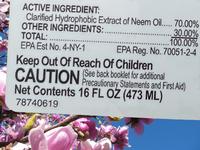
More information: More about Neem |
Nematode Control with MarigoldsSome varieties of marigold can suppress certain damaging nematodes while adding color to the garden. The Tagetes species suppress root knot and lesion nematodes. French marigolds, including Nemagold, Petite Blanc, Queen Sophia, and Tangerine, are most effective. Avoid signet marigolds, T. signata or tenuifolia, because nematodes will feed and reproduce on these. Marigolds don’t work well against the northern root knot nematode, Meloidogyne hapla, a species common in areas with cool winters. The effect of marigolds is greatest when grown as a solid planting for an entire season. When grown along with annual vegetables or beneath trees or vines (intercropping), nematode control usually isn’t very effective. To prevent marigold seed from getting in the soil, cut or mow the plants before the flowers open. As with other cultural control methods, nematode populations rapidly will increase as soon as susceptible crops are grown again. Learn more at the UC Pest Note on Nematodes. |
Oak Root FungusThis fungal infection, Armillaria Mellea, also known as mushroom root rot, honey fungus and shoestring fungus can cause foliage to become sparse and eventually kill the tree. The white or cream-colored fungus will grow between bark and wood of roots and up into the lower part of the tree trunk. It smells like your typical grocery store mushroom. In spring or fall there may be mushrooms growing around the base of the infected tree. If the disease has not progressed too far, you can cut out infected tissue and expose the base of the tree and roots to air. Reduce watering especially close to trunk. No chemical treatment is known to be effective. Plants Resistant or Susceptible to Armillaria mellea, The Oak Root Fungus by Robert D. Raabe contains more detailed information. The UC Master Gardener video Revealing Root Rot can help with detection of two common root pathogens and provide guidance on how to reduce the spread. |
OakwormThis is a pest of California Live Oaks. The adult oakworm moth is tan-to-gray colored with a wing span of about an inch. It lays white eggs twice a year that turn reddish or brown before hatching. The first hatch is in November and overwinters on the leaves, growing and eating more as the weather warms. At full size, the larva is about an inch long with a yellowish green body, dark stripes down the side and large brown head. Outbreaks occur every eight to ten years in the Bay Area. In late March or April, look for little green pellets (droppings) falling from oak trees. A second generation of eggs hatches in mid to late summer. Trees may suffer no permanent damage beyond being unsightly. If you cannot tolerate the worms and their mess, further treatment methods are outlined in the UC Pest Note on California Oakworm. |
Paint Fruit Trees to Prevent SunburnAfter deciduous fruit trees have dropped their leaves, paint tree trunks with white latex paint diluted 1:1 with water to prevent sunburn. Preventing sunburn helps trees resist invasion by shot hole borers, which are tiny beetles that boreholes and lay eggs in the cambium layer of the tree. When the eggs hatch, young larvae feed and excavate tunnel galleries in the wood. For more information about identification and control see UC Pest Note on Shothole Borer.
|
Peach Leaf Curl Preventive CareHave your peach or nectarine leaves ever looked like this? These puckered leaves are a classic springtime symptom of peach leaf curl. Severe cases can substantially reduce fruit production. Prevent this disease by applying a copper-based fungicide shortly after the leaves drop. Use a second application in late winter if there’s a lot of winter rain. Once the blossoms open and leaves appear, it’s too late to do anything. Spraying during the growing season won’t help. If you haven’t seen this on your tree, you may have a resistant variety. If so, there’s no need to spray.
More information: Pear Leaf Curl |
Peppertree PsyllidsThis pest can cause damage to California pepper trees. The damage is done when the insect is in its immature stage. They make doughnut-like pits on leaves that wrinkle or twist the leaves as well. Parasitic wasps can provide satisfactory control. See the UC Pest Note on Psyllids for more information. |
Plum Bud Gall MitePlum bud gall mites are tiny and you won’t be able to see them without magnification. Their feeding causes the galls to form on the tree. These galls are made up of different chambers and these chambers can be filled with a large population of mites. The mites are primarily dispersed by wind but can be spread by insects, birds, and infected budwood. Heavy infestation can weaken trees and in some cases cause the death of the tree. If you suspect that your tree is affected by these mites, you should avoid moving budwood off your property to keep from spreading the pest. Because they are a new pest, options for managing them are still being developed. See Plum Bud Gall Mite for further information.
|
Poison OakPoison oak is a California native plant that provides shelter and food for many native birds and other creatures. The downside is that at least 75% of us develop allergic contact dermatitis to the plant. Unwanted poison oak can be pulled or dug up by allergy-resistant friends, remove plants in early spring or late fall when the soil is moist and it is easier to dislodge rootstocks. A complete list of management options, including herbicide control, is contained in the UC Pest Note on Poison Oak. Under no circumstances should poison oak be burned. |
Powdery Mildew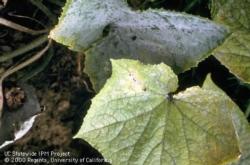
Powdery mildew on squash leaves
Powdery mildew likes warm days and cool nights. Unlike most other fungi, it does not need moisture to thrive. Early symptoms include yellow chlorotic spots on the leaves. The presence of the fungus becomes obvious as it starts to produce spores that look like white powder on leaves. Eventually, the leaves will turn brown and dry. The best defense is to plant varieties that are resistant to powdery mildew. Also helpful is planting in full sun with good air circulation through the plants. Washing off the leaves, preferably in the morning, can buy some time. Powdery mildew generally affects the older leaves first, and you can remove these when they are too covered to be able to photosynthesize. Fungicides can help but you want to be careful about using them around something you are going to eat. At some point, the plant may decline so much that it needs to be removed. More Information: Powdery Mildew on Vegetables
|
Protecting Birds and CropsThis is nesting season for many birds, so be sure to check for active nests before pruning trees. Birds are good for natural pest control, as they eat many insects, and they improve your garden’s biodiversity. You can also encourage birds in your yard by providing food and water for them. Just be sure the water stays fresh and clean. To protect fruit and nut trees from marauding birds, PVC structures covered with netting can save your crop. If netting is placed directly on the tree, birds will still be able to reach much of the fruit. There's more information in the UC Pest Note on Birds on Tree Fruits and Vines. |
Protecting CaliforniaOur Agricultural Commissioner, County Biologists, UC Master Gardeners, Cal Fire, and other interested parties are always on the lookout for new pests and diseases that can threaten our agricultural economy, our gardens, and our safety. As observant gardeners and residents we can also do several things to help. Do not transport plant material from other areas unless it has been inspected, approved, or otherwise deemed safe. This includes firewood, unpackaged seeds, fruits and vegetables, and green waste. Nursery stock is inspected and is considered generally safe. Obey any quarantines in effect. Report any suspicious pests to the Master Gardener Help Desk. Do not transport a sample to the office unless instructed to do so. Master Gardeners will help identify the pest and connect you with any appropriate agencies.
|
Protecting FruitIf you don't eat your fruit the minute before it's ripe, birds or squirrels will. Once you see signs of damage, either pick the fruit, or find a way to protect it. For example using netting or paper bags. Pick up any fallen fruit as so not to attract rats or other less visible pathogens. |
Rat Management
Rats show up when your citrus, tomato, or fruit first starts to ripen. Rats are agile climbers and usually live and nest in shrubs, trees, and dense ground cover like ivy. One management strategy is to prevent access to the tree by cutting branches away from fences or other trees, leaving a gap of at least 2–3 feet, good sanitation is required. Garbage and garden debris should be eliminated. Use tight-fitting lids on garbage cans. Thin out dense vegetation to make the habitat less desirable. Mow ivy once a year to the ground. Climbing ivies on fences or buildings should be removed. Per the UC pest note (linked below), trapping is the safest and easiest method for controlling rats. Read the pest note for other management strategies as well. More information: Rat Management |
Root Knot Nematodes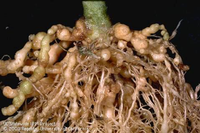
More information: Nematodes Pest Note |
Rose CareRoses are notoriously susceptible to many diseases, including rust, black spot, and powdery mildew. For this reason, they are often planted at the edges of vineyards to give an early warning about diseases that can affect the vines. Yet not everything that negatively impacts roses is a disease or pest, so don’t automatically reach for the chemicals. Abiotic disorders are caused by nonliving factors and can be addressed with cultural changes. Blackened areas on canes can be from sunburn. Brown-edged leaves may signal a high concentration of salt in the soil. Yellow leaves may be due to nutrient deficiencies. Deformed growth may be due to exposure to glyphosate, the active ingredient in Roundup. Good air circulation allows the morning dew to dry, and helps prevent rust and powdery mildew. Some practices to keep your roses healthy are to choose hardy varieties, enrich the soil with compost, fertilize regularly but not too much, irrigate directly to the root zone, and remove suckers (the rapid-growing, long canes) from roses. Prune them below the bud union.
|
Snails and Slugs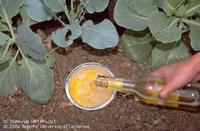
More information: Snails and Slugs |
Sooty MoldIf your citrus leaves have a black coating, you may have a sooty mold problem. This black mold can also be seen on citrus fruit, avocado leaves, magnolia leaves, hibiscus, other host plants, and even on sidewalks beneath trees.
The sooty mold fungi grow on “honeydew”, a sticky substance excreted by plant-sucking insects such as aphids, scale, mealybug, and whitefly. They suck the sap out of plants and excrete excess sugars. It exists purely on the surface of a plant and is not a systemic issue. By itself, the fungi cannot kill the plant but it can coat the leaves to the extent that sunlight is prevented from reaching the leaf surface, thus reduce photosynthesis. Ants protect the sucking insects from their predators so they can eat the honeydew. Keep ants out of trees and away from honeydew-producing insects by applying a sticky compound such as Tanglefoot on a tape wrapped around the trunk. Pruning branches to allow better air circulation also helps. You can hose off the mold itself with a strong jet of water. And you can eat the fruit once you wash off the sooty mold.
For more information, see Sooty Mold Management Guide.
|
Spider Mites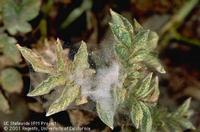
More information is available in the UC Quick Tips on Spider Mites. |
Spotted Wing DrosophilaUnfortunately, the Spotted Wing Drosophila is infesting local cherry, berry, and some other fruits. Look for holes in the fruit. Once the eggs hatch, maggots develop and feed inside the fruit, causing the flesh of the fruit to turn brown and soft. Dispose of infested fruit. Information on identification and control can be found in the UC Pest Note on Spotted Wing Drosophila. |
Squash BugsSquash bugs are about ½ long, brownish yellow and flattened like a stink bug. Zucchini is one of their favorite plants. Leaves will blacken and drop as they dry. They can be difficult to control. Placing row cover over young plants helps prevent infestation. Remove nearby vegetation where the bugs can over winter. More information can be read at UC Pest Note on Squash Bug. |
Squirrel Control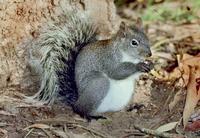
For more information: Pest Note on Tree Squirrels and Pest Note on Ground Squirrels. |
Stink BugsStink bug's eggs are white in barrel-shaped cylinders with concentric circles ending in a bull’s eye. You might find them on the underside of leaves or in plain sight on fruits and vegetables in your garden. Soon they will hatch, shapeshifting in appearance five times before becoming shield-shaped adults either in brown or green color. Called stink bugs because they excrete a smelly fluid when disturbed. These insects feed on a variety of fruits, nuts, and vegetables such as tomatoes, squash, and beans, leaving blemishes and dark pinpricks in their wake.

Green stink bug instar (nymph) stages by Herb Pilcher, USDA-ARS, adult by James Castner, University of Florida
More information: UC Pest Note on Stink Bugs |
Sudden Oak DeathSudden oak death is a disease of oak trees caused by an invasive plant pathogen, Phytophthora ramorum. It occurs in Santa Clara County as shown on this map. If your oak tree went from healthy (green) to dead (brown) with a full complement of dead lives on the tree, it might have died from sudden oak death. More details about what to do are available at UC Pest Note on Sudden Oak Death. |
Sunscald on Fruits and Vegetables
Fruits and vegetables can get sunburned in the summer heat. This is more commonly called sunscald and it frequently affects peppers, tomatoes, and persimmons. The leaves shield the produce from the sun, so it helps to make sure the plants have sufficient fertilizer and water for a healthy plant. You can cut out the damaged parts and eat the rest of the fruit. |
Termites
See the UC Pest Note on Termites to identify which type is present and the methods of control. Learn all you can before calling in the professionals. |
Tick InformationTicks are abundant after mild winters and they can carry dangerous diseases. To learn more about ticks, see the UC Pest Note on Lyme Disease. Be sure to visit the County of Santa Clara website for information about ticks. |
Tomato blossom end rot
|
Tomato Bottom Scarring
Sometimes scarring can be seen on the bottom (blossom end) of tomatoes. This can be caused by weather conditions such as cool and cloudy weather at bloom time, making the blossom stick longer to the small fruit. The fruit is perfectly good to eat with the damaged part cut out. Some large heirloom tomatoes are more susceptible to this condition. Also known as catfacing. |
Tomato HornwormBoth tomato hornworms and tobacco hornworms can do significant damage to tomato plants. They can eat entire leaves and take bites out of the fruit. Although they are large with a striking appearance, they camouflage themselves well on plants and can be surprisingly hard to find. Once you see one, you’ll wonder how you missed it. The first clue to their presence is often a pile of frass (insect larva excrement) on the leaves or ground under the pest. They are up to four inches long so they are easy to handpick for disposal. If you see a row of white eggs on their backs, those are from a parasitic wasp that will take care of the problem naturally. They are striking, with white striping and little round circles. The caterpillars get their name from the horn on their back end, and they are the larval stages of rather large brown moths.
More information: Tomato Hornworms
|
Tomato Russet MiteTomato russet mites deplete juice from the cells of leaves, stems and fruit. They usually start at the base of the plant and move upward. If not controlled, these pests can kill plants. At first sign of damage, treat with sulfur dust or a spray solution of wettable sulfur and spreader-sticker. More information is found in the UC Pest Note on Tomato Russet Mite. |
Verticillium WiltVerticillium wilt is a soil-borne fungal disease that damages plant veins. The damage is characterized by affecting one side of the plant. The leaves may wilt and turn brown, dying upward from the base of the branch to the tip. Dead leaves often fall, but may not. Mildly affected plants may survive if fertilized and encouraged into vigorous growth. The fungus can live for years in the soil. Planting tomatoes, peppers, eggplants, and potatoes (all members of the Solanaceae or nightshade family) in the same place no more than once every three years helps reduce the fungal population to non-harmful levels. Soil solarization may eliminate Verticillium wilt from infected soils. Crop rotation with cereals or broccolis can reduce the pathogen. Avoid high nitrogen fertilizers. Plant Verticillium wilt-resistant varieties of tomatoes, potatoes or strawberries. Refer to the UC Pest Note information on Tomato, Potato, and Strawberry for species-specific suggestions. |
Vinegar as Weed ControlVinegar can work as a weed killer, but its effectiveness is limited. Household white vinegar (5% acetic acid) is too weak to kill anything other than tiny seedlings. Stronger horticultural vinegars with 20% acetic acid provide better weed control but typically only for annual, not perennial, weeds. And the higher concentration can be dangerous—including skin burns and eye injury—if not handled carefully. For comprehensive guidance on weed management in landscapes, refer to the University of California’s Weed Management in Landscapes recommendations. |
Weed Management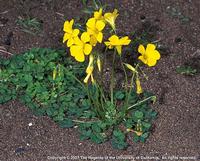
Photo: Oxalis pes-caprae aka Bermuda buttercup, by Joseph DiTomaso, UC ANR
Whichever variation of “One year’s seeds makes seven years’ weeds” you prefer, the truth remains: a key part of weed control is not letting them go to seed. For best results, work on removing weeds before they are able to propagate. Hand pulling and hoeing are effective methods for killing many common weeds.
Knowing what kind of weeds you have and how it propagates can be helpful in choosing the best management method. If they propagate by seed, pull or hoe them before they flower and go to seed. If they re-grow from roots, pull up as much of the root as possible. Many weeds, like Bermuda grass, have multiple ways of multiplying. Only non-propagating parts are advisable to throw in the compost bin.
More Information: UC Quick Tips on Weeds in Landscapes
|
White Mold on Lettuce and Brussels SproutsWhite mold is a distinctive disease that most often affects stems and foliage at the base of cole crops* and lettuce plants. Affected tissue develops a soft, watery rot and white, cottony mycelium forms on the surface. Plants may wilt if stems are girdled by the decay. As affected tissue dries up, it turns yellow to white, and hard black sclerotia form on the surface or inside the dead stems. Get more information in the UC Pest Note on White Mold. * Cole crops include broccoli, Brussels sprouts, cabbage, cauliflower, collards, kale, and kohlrabi |
WhitefliesWhiteflies are tiny, sap-sucking insects that may become abundant in vegetable and ornamental plantings, especially during warm weather. They excrete sticky honeydew and cause yellowing or death of leaves. Outbreaks often occur when the natural biological control is disrupted. Management is difficult once populations are high. |
Yellowjackets and WaspsThese insects can be solitary or live in group nests above and below ground. Yellowjackets can be aggressive when defending their nests. Since they nest in ground holes or inside walls and ceilings, you might encounter them on a hike or in your home. Avoid the area when possible. Paper wasps on the other hand, are relatively unaggressive, but they can be a problem when they nest in a trafficked location. When eating outdoors, keep foods well covered. One strategy is to put out bait such as a piece of meat or an opened soda can some distance from the table before setting out the human food. Or, use a lure trap around the area you want to protect. Trapping the queens in the spring and workers during the summer can reduce local populations. See the UC Pest Note on Yellowjackets and Other Social Wasps for more information. |







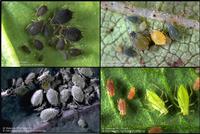
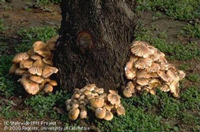
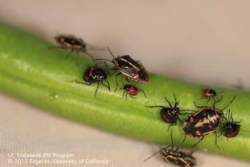
 Bitter pit is a physiological disorder that affects many varieties of apples. The condition develops after fruit has been picked. It is caused by low levels of calcium in fruit tissues which leads to small brown, sunken lesions that become dark and corky. Highly susceptible cultivars include Red Delicious, Granny Smith, Golden Delicious, Jonathan and Gravenstein. The
Bitter pit is a physiological disorder that affects many varieties of apples. The condition develops after fruit has been picked. It is caused by low levels of calcium in fruit tissues which leads to small brown, sunken lesions that become dark and corky. Highly susceptible cultivars include Red Delicious, Granny Smith, Golden Delicious, Jonathan and Gravenstein. The 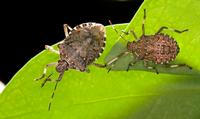
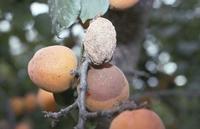 If your apricots or peaches had brown flesh last year, especially in the part surrounding the pit, they were probably infected with brown rot. It's a common fungal disease of stone fruit. You can spray with a copper spray at pink bud stage. A more important means of control is to remove affected fruit as soon as you notice it. The
If your apricots or peaches had brown flesh last year, especially in the part surrounding the pit, they were probably infected with brown rot. It's a common fungal disease of stone fruit. You can spray with a copper spray at pink bud stage. A more important means of control is to remove affected fruit as soon as you notice it. The 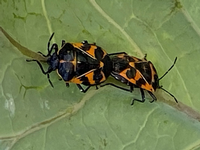
 Have you ever seen weirdly shaped lemons or oranges that appear to have 'fingers'? This condition is caused by the Citrus Bud Mite.
Have you ever seen weirdly shaped lemons or oranges that appear to have 'fingers'? This condition is caused by the Citrus Bud Mite. 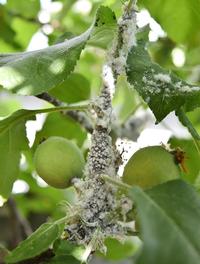
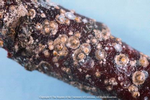

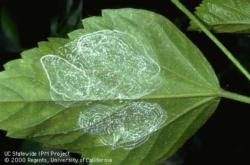 If you see white beardlike filaments handing from the leaves of your hibiscus, bird of paradise, or other plants, you may have giant whitefly. Another sign is the distinctive wax spirals on the undersides of the leaves. They can usually be controlled by washing them off or removing affected leaves. For more information see
If you see white beardlike filaments handing from the leaves of your hibiscus, bird of paradise, or other plants, you may have giant whitefly. Another sign is the distinctive wax spirals on the undersides of the leaves. They can usually be controlled by washing them off or removing affected leaves. For more information see 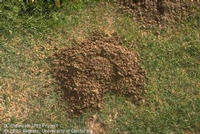

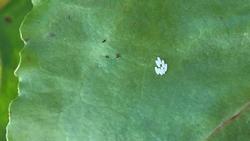

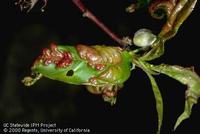

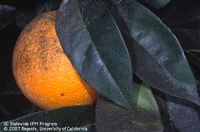
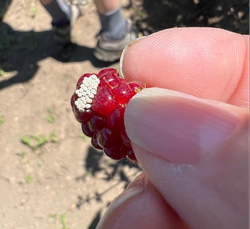
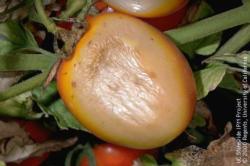
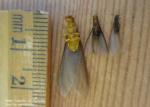 Termites are very common in Santa Clara Valley. The first sign of infestation may be the presence of winged forms or fecal pellets pushed out of the infested wood.
Termites are very common in Santa Clara Valley. The first sign of infestation may be the presence of winged forms or fecal pellets pushed out of the infested wood.  A brown depression on the bottom of tomatoes is usually blossom end rot (BER). This disorder is related to a calcium deficiency aggravated by irregular watering. Since most soils have adequate calcium, watering is usually the problem. Without regular watering, the calcium in the soil cannot reach the plant. Mulching can help. Water tomatoes regularly. Avoid flooding them so the roots sit in water. For more detailed information about BER please view
A brown depression on the bottom of tomatoes is usually blossom end rot (BER). This disorder is related to a calcium deficiency aggravated by irregular watering. Since most soils have adequate calcium, watering is usually the problem. Without regular watering, the calcium in the soil cannot reach the plant. Mulching can help. Water tomatoes regularly. Avoid flooding them so the roots sit in water. For more detailed information about BER please view 
